The Arctic can seem like such a faraway place, almost if not entirely mythical as it is the setting for so many of our childhood stories. This elusive place existing north of everything familiar contains Arctic animals just as magical and exciting. These unbelievable creatures’ innate ability to thrive in the most inhospitable environment is magic indeed.
Travel to the Arctic offers us a peek into their innovative and sometimes seemingly odd adaptations, and to learn how Arctic wildlife relate in their world—and how we relate to theirs. With recent advances in ship technology and range, the modern traveler now has the unique chance to visit these remote locales with comfort and relative ease aboard a host of expedition ships and/or adventure lodges. Learn about these incredible creatures and all their fur and blubbery, along with tips for spotting these iconic Arctic animals, then get yourself on an Arctic expedition trip to see them for yourself.
IN THIS POST – Arctic Animals:
Polar Bear
Walrus
Reindeer (Caribou)
Arctic Fox
Narwhal
Puffin
Beluga Whale
Musk Ox
Wildlife Spotting Tip
1. Polar Bear
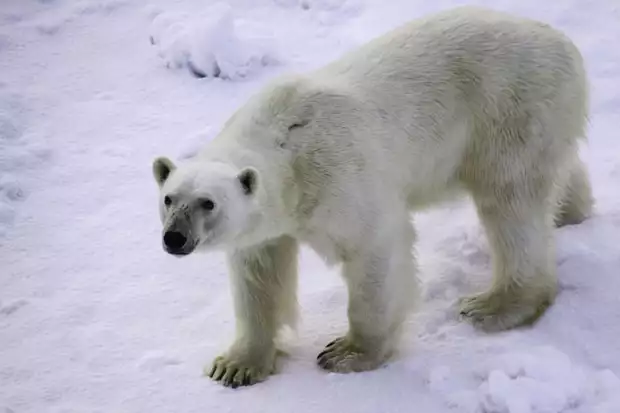
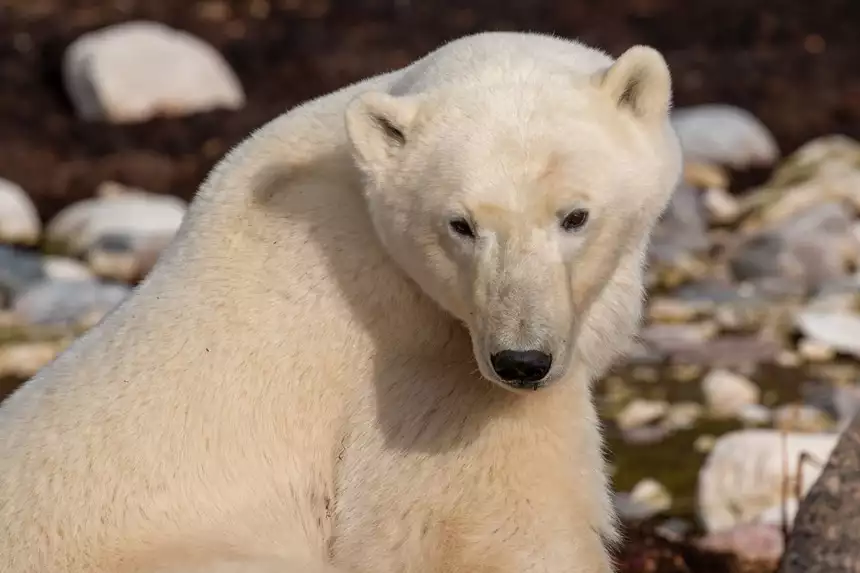
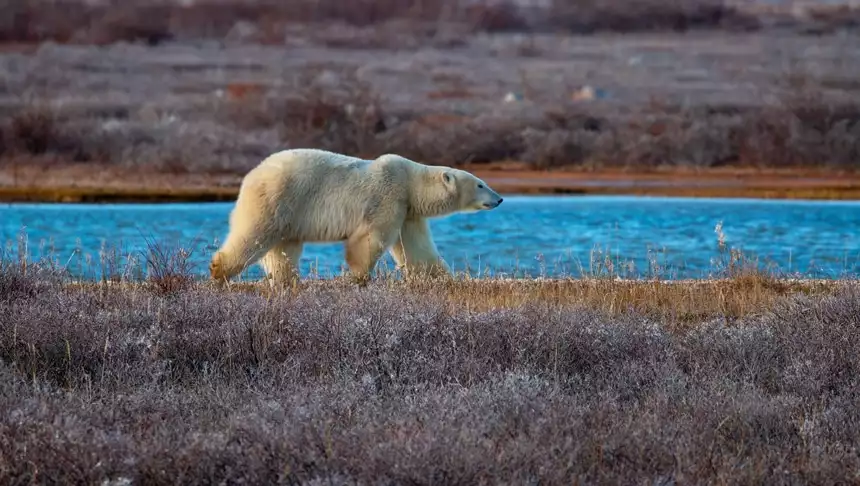
Polar bears are the largest living carnivores on Earth at up to 8 feet long and 1,500 pounds.
A large draw to the Arctic is of course the iconic polar bear. These massive Arctic animals have been made even more famous by their declining numbers due to late-forming and early-melting sea ice, which drastically limits their hunting abilities. As the largest living carnivores on Earth at up to 8 feet long and 1,500 pounds, polar bears need a lot of caloric intake. Their main strategic advantage is to wait by seal breathing holes in the ice to snatch them up for a fat-filled meal using their highly sensitive sense of smell to locate them under three feet of water. Polar bears also scavenge for carcasses of other mammals, birds and eggs and can smell their prey on land up to 10 miles away.

These marine mammals are also excellent swimmers with webbed paws, swimming up to 6 mph and for long distances between ice floes. 26,000 wild polar bears are currently estimated to be roaming the Arctic and are found in the northern areas of Canada, Alaska, Greenland, Russia and Norway. Our founder and president came face to face with the King of the North, read his first hand review of our dedicated polar bear trip in Expert Review: Classic Polar Bear Adventure.
2. Walrus
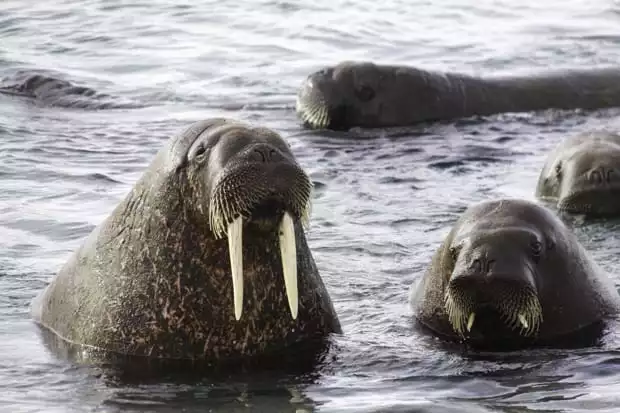

Walrus can be seen on many voyages north as they live in the Arctic areas of the Pacific and Atlantic oceans. These blubberous creatures are often viewed lounging around in large herds on shorelines or icebergs. They are quite mellow animals, only becoming aggressive during mating season, and this laidback attitude may have been a cause for their dwindling numbers as they were so easy to hunt. Since 1980 their population has revitalized with only Native peoples permitted to sustainably hunt them.
Walrus’s unique and obvious adaptation is their unusual long tusks, which keep growing throughout their lifetime and can reach up to three feet. These powerful tools help them climb their massive body weight onto the ice floes, break through the ice when they are swimming, defend themselves and establish dominance over each other. Their other unique feature is their mustache of whiskers, which is used to locate shellfish in the depths of the dark Arctic ocean (they can hold their breath for 10 minutes!)
3. Reindeer (Caribou)
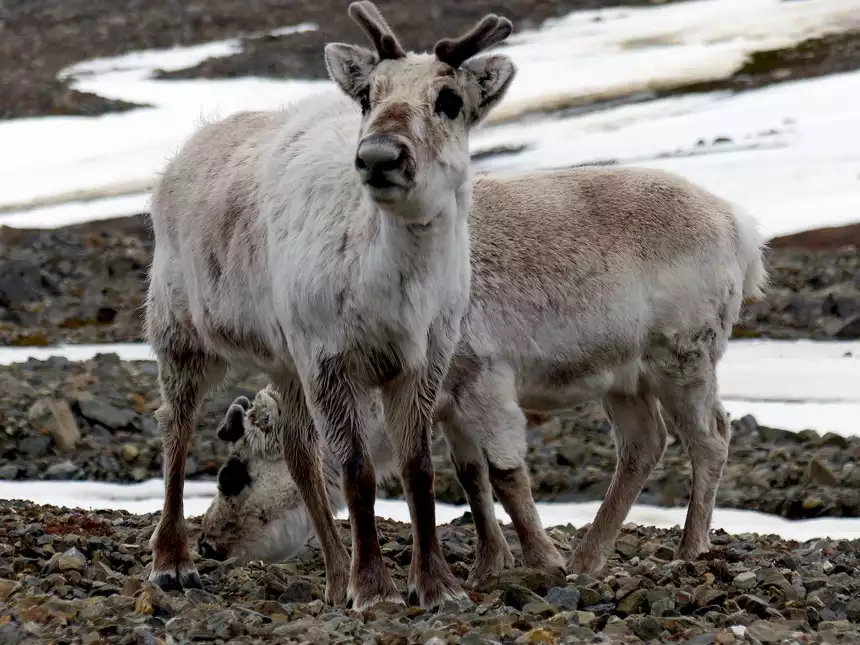

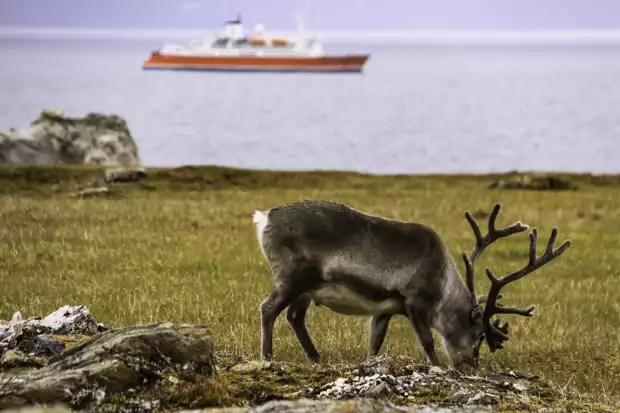
Reindeer, or caribou as they are known in North America, are a true Arctic mammal that lives on the tundra as well as in boreal forests. They can be found in Eurasia, North America, Greenland and on large northern islands. Both the males and the females grow antlers, which fall off every year to regrow. The males use them for sexual attraction and mating standoffs; the females use them to defend their food from other females. Reindeers have special noses that help regulate their body temperatures by altering the air temp that goes into their lungs.

North American caribou have been known to migrate over 3,000 miles a year. Reindeer are social animals that travel in herds from 10 to a few hundred, to spring sizes reaching into the thousands. Reindeer shift their migration routes each year to avoid overgrazing. They live off of herbs, ferns, mosses, grasses, shoots, fungi and leaves and often most importantly, lichen, which can offer a much-needed food source during the harsh winter.
4. Arctic Fox
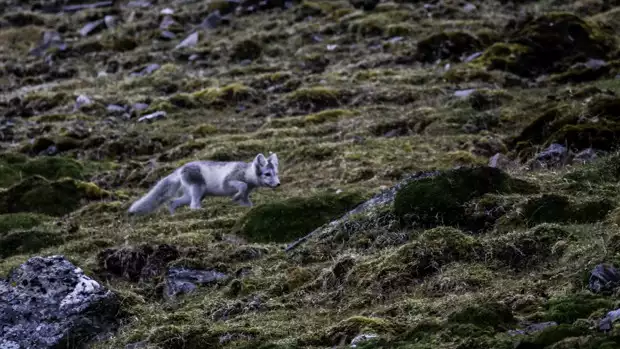
The thick fur of the arctic fox keeps them alive in the harsh Arctic climate; they have been known to survive temperatures as low as -58 degrees Fahrenheit.
Arctic foxes have many features they have adapted to allow them to survive the harsh climate of the Arctic. They are fantastic burrowers, allowing them to tunnel their way under the snow to create dens where they seek refuge from the elements and stockpile food. They feed off birds, eggs, lemmings, voles, mice, carrion and shellfish, and hunt with their incredible hearing that allows them to locate their prey under the snow; they then leap to break the snow and gather the prey below.

Their thick, long fur is adapted to change seasonally becoming white or blue-gray in the winter to brown-gray in the summer, providing excellent camouflage. Its thickness keeps them alive as they have been known to survive temperatures as low as -58 degrees Fahrenheit. This coveted, beautiful fur has also been prized by trappers, who now farm arctic foxes in a large commercial industry. Fortunately, their numbers in the wild still range in the hundred thousand. They primarily live on the tundra or in northern wooded areas of Alaska, Canada, Greenland, Russia, Norway, Scandinavia and Iceland.
5. Narwhal
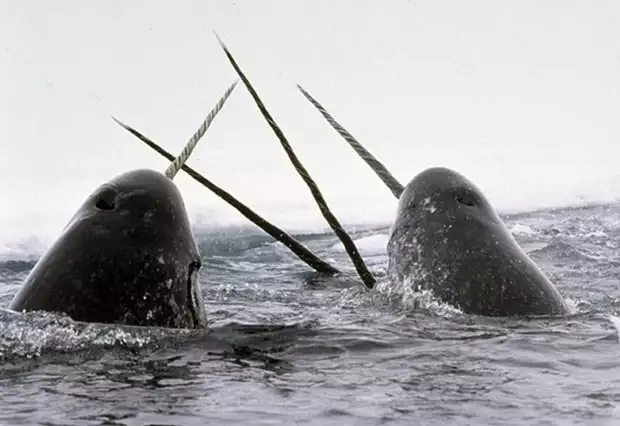
The narwhal tusk is a specialized sensory organ with 10 million nerve endings that allow them to pick up changes in the environment.
Narwhals are one of Earth’s most unusual creatures, one that makes you ask “why?” It turns out that the narwhal is another incredibly adapted Arctic animal that uses its special features to survive in the harsh environment. The narwhal tusk is the iconic feature that stands out among these mythical animals. This tusk is actually a spiral tooth that can grow as long at 10 feet. Most males have tusks, with some even having two. Surprisingly, it is a specialized sensory organ with 10 million nerve endings that allow the narwhals to pick up changes in the environment, aiding in locating food and mates. It is also possibly used to stun fish before eating them. Narwhals eat cod, halibut, shrimp, squid, flounder, crab and rockfish.

These mammals are found in the waters of Canada, Greenland, Svalbard,
Franz Josef Land, Russia and Baffin Bay, where they are known to
congregate for up to five months in the winter. Their population is
around 80,000 and they travel in packs. Narwhals have unique splotches
of blue, gray and cream on their body and these markings change with
age; they get whiter as they grow older. The exceptional tusks are
prized by collectors, making narwhals a target of hunters; fortunately
there are regulations and quotas that are monitored.
6. Puffin
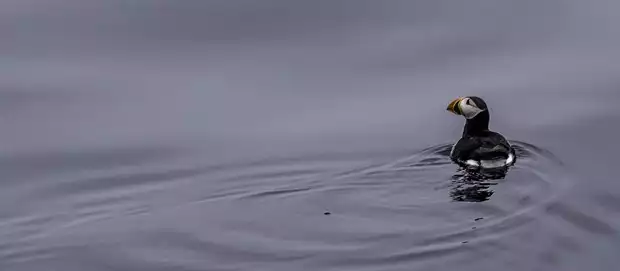
Puffins, the cute white-and-black birds with orange beaks, have a look of concern and compassion in their eye, making them quite endearing and photogenic. These adorable birds are excellent flyers and can fly up to 55 mph and spend most of their time at sea fishing for crustaceans, squid and fish.
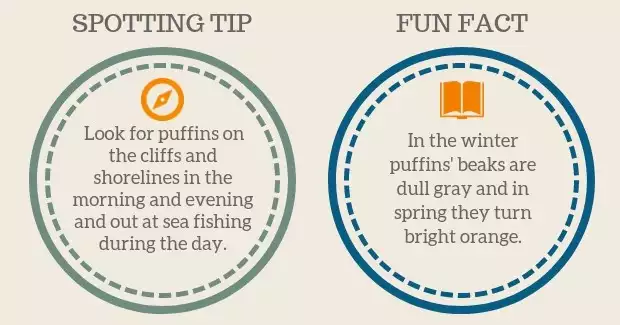
In the spring and summer they return to their colony on land to mate and create burrows in the ground, under rocks or under cliffs to incubate their egg. Their colonies consist of thousands of birds and yet they tend to mate with the same partner every year. These cartoonish birds are found in the northern areas of Canada, United States, Europe and Iceland, where 60% of the population is found.
7. Beluga Whale
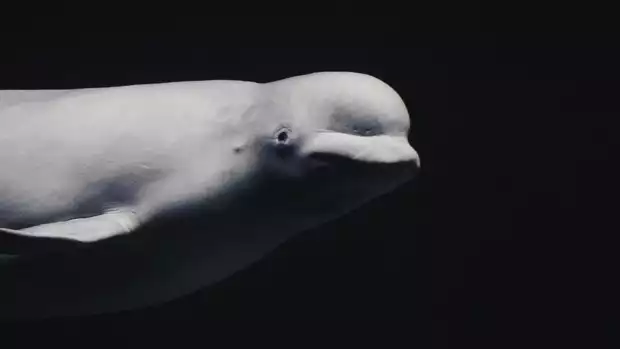
The beluga whale is the only whale that can turn its neck.
The stark whiteness of the beluga whale draws our attention, yet these Arctic animals have even more intriguing adaptations than are seen at first glance. Belugas have a unique neck allowing them to turn their heads almost completely sideways to create a right angle. This allows for special maneuverability for harvesting food and allows them to be able to swim backwards. They feed on schooling fish, crustaceans, worms and mollusks.

They use their specialty sonar skills to echolocate their prey and
use their incredible communication to work together to force fish into
compromising situations. These mammals are highly vocal and make a
variety of sounds for communication in their social pods with up to 100
individuals. Belugas live in the Arctic areas of Russia, Greenland,
Canada, Norway and Alaska and are seen in big groups in Churchill,
Canada in July and August.
8. Musk Ox
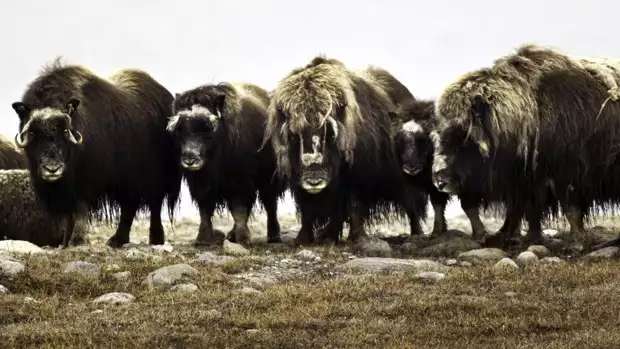
Surviving the Ice Age is no joke, and musk ox are one of the few hooved animals to have made it through (reindeer did as well). Their long, shaggy hair can grow to two feet long and has two specialized layers for Arctic survival: the top guard hair and the undercoat (the latter provides warmth that is eight times warmer than sheep’s wool). Moving around in the winter, musk ox travel in herds of 12 to 24 to forage for roots, moss and lichen that they dig for with their hooves. In the summer, herds of 8 to 20 range farther distances eating flowers and grass. A herd is controlled by the dominant male, until a female is pregnant and then she leads the pack searching for food.

Musk ox work together to avoid predatorial threats, using horns and
their numbers to keep safe. There are estimated to be 80,000 to 125,000
musk ox alive today. Although humans almost hunted them into extinction,
fortunately they are now protected and live in Canada, Alaska,
Greenland, Siberia and Norway.
The Ultimate Arctic Wildlife Spotting Tip
Go with a skilled guide. Fortunately, here at AdventureSmith Explorations we have a wide range of Arctic expedition cruise options to get you into the expanse of the Arctic landscape where foxes burrow, polar bears roam and walrus lounge—all with well-trained guides and naturalists that know the best sighting spots and animal behaviors. Our options to explore the Arctic range from Norway’s Svalbard Archipelago to Greenland and Iceland cruises, and over to the Canadian High Arctic and Alaska. Itinerary options even include the opportunity to reach the North Pole.
It is time to make these mythical lands real; travel on a small ship Arctic cruise or visit a remote wilderness lodge on an Arctic land tour to spot these Arctic animals, to learn about what is happening to protect them and to find out what we can do to help. Come home with your mind filled with awe and share your own mystical tales.


MORE ARCTIC RESOURCES:
Arctic Expeditions
Arctic Tours
Arctic Cruises
Svalbard Polar Bear Cruises
North Pole Cruises
Northern Lights Cruises
Arctic vs Antarctic Cruises
Iceland Cruises
Greenland Cruises
Arctic Cruise Deals
Arctic Trip Reviews
Arctic fox, puffin, walrus with Zodiac and beluga whale pod photos were taken by AdventureSmith Specialist Andrew Browning; beluga whale photo was taken by Mendar Bouchali and musk oxen photo was taken by Quark Expeditions.
Comments will be moderated and will appear after they have been approved.